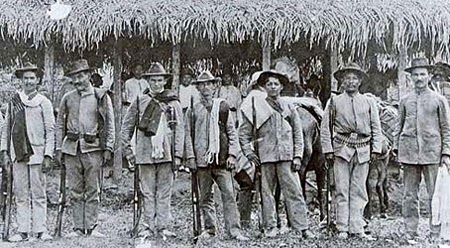 |
| War of the Thousand Days in Colombia |
The War of the Thousand Days in Colombia lasted from October 1899, when the Liberals staged a revolt to unseat the Conservative government, to November 1902. It is estimated that 100,000 people died during the war, which left Colombia and Panama (then a part of Colombia) devastated. It also led to the secession of Panama.
There had been much instability in 19th-century Colombia with the 1863 constitution suppressed in 1886 and a new constitution established. This failed to end the period of confrontation between the Liberals and the Conservatives, the latter managing to manipulate the electoral system to remain in power. With President Manuel Antonio Sanclemente being too ill to administer the country, there was a power vacuum which Liberal generals hoped to exploit.
The Liberal generals planned a coup d’état for October 20, 1899, but the date was brought forward to October 17 at the last moment. Instead of being a relatively straightforward conflict, many Liberals were hesitant about becoming involved in the war, some for fear of the consequences of failure, others because they were unsure whether they wanted a civil war. The outbreak of the rebellion was in Socorro, Santander, with rebels who had trained in Venezuela ready to come over the border.
  |
The Conservative government immediately sent their loyal commanders to Bucaramanga, the capital of Santander, but the soldiers were unhappy about being paid in what they felt was worthless paper money. This stopped the Conservatives from ending the war with a quick victory.
However, they did manage to defeat some of the Liberals at the Battle of the Magdalena River on October 24. They were unable to follow up their victory. The Conservatives split into two factions, the “historical” and the “national.” Sanclemente was deposed and replaced with José Manuel Marroquín.
At the same time, the Liberals, who also split into two factions, the “pacificists” and the “warmongers,” nominated one of their leaders, Gabriel Vargas Santos, as their president, and the scene was set for a civil war.
At the Battle of Peralonso, the Liberals led by Rafael Uribe defeated their opponents, but at the Battle of Palonegro, the Conservatives were able to crush the Liberals. The Venezuelans intervened to support the Liberals, but the Conservative Commander Marroquín managed to block them from coming to the aid of their allies.
With neither side able to deliver a decisive blow, the first peace agreement was signed at the Neerlandira plantation on October 24, 1902. Fighting continued into the following month in Panama, and finally, on November 21, the final peace agreement was signed on the U.S. battleship Wisconsin.
This ended the war that had wrecked the economy of the country but had also confirmed the split in Colombian society that was to lead to Panama being created as an independent republic on November 3, 1903.